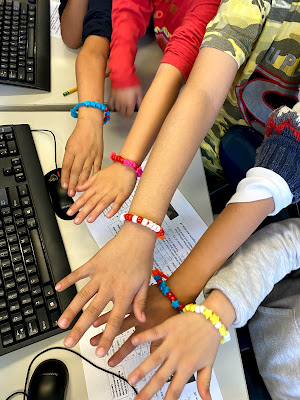Tuesday, December 10, 2019
CSEdWeek Togetherness Tuesdays
At school, we have Togetherness Tuesdays to encourage more families to spend some unplugged quality time together. They can play a game, read a book, watch a movie, cook a dish, or bake some cookies. Another way to celebrate CSEdWeek is to do some sketching and coloring together, and learn about algorithms along the way.
The first one is to help Snowy and Frosty build a friend by following an algorithm. My five year old son really enjoyed this activity and helped me come up with two more. In the Slides, you will find Snowy and Frosty need your help to build a home, and create a car to go to the market. Feel free to print and use it with your students.
Editable Resource:
Snowy&Frosty's Winter Algorithm
Happy Coding!
Labels:
#cs4all,
#cs4allnyc,
#csedweek,
#hourofcode,
algorithm,
art,
classroom,
coding,
colors,
computational thinking,
computer,
csedweek,
elementary school,
hour of code,
program,
programming,
social emotional
Sunday, December 8, 2019
Celebrating CSEdWeek
CSEdWeek is December 9-15 this year! How are you celebrating? At our school, our principal is adding a fun fact about a pioneer in his morning announcement. Of course, there are many more heroes in computer science, so this is one small way to raise awareness of the people who've made an impact in our daily lives.
Editable Resource:
CSEdWeek Pioneers
In the computer lab, we are creating binary code bracelets to teach students about the computer science word, binary, which means a way of representing information using two options.
Editable Resource:
CSEdWeek Pioneers
In the computer lab, we are creating binary code bracelets to teach students about the computer science word, binary, which means a way of representing information using two options.
Editable Resource:
Happy Coding!
Labels:
#cs4all,
#cs4allnyc,
#csedweek,
#hourofcode,
algorithm,
art,
classroom,
coding,
colors,
computational thinking,
computer lab,
csedweek,
elementary school,
elementaryschool,
hour of code,
programming,
resources
Thursday, April 18, 2019
CS First Club Game Design
I've been using Google's CS First's Game Design and created a chart and checklist for students to use as they complete each activity. It's an awesome club that can be used with Scratch. The best part is it's FREE! Read more about it on my guest post on EducateLLC, "CS First Clubs: A Success Story in the Lab". It will discuss how to get started easily.
The Game Design Process involves three steps.
1. Prototype: What is the goal? What do you plan to create?
2. Playtest: What happens when you run the program? What do you notice?
3. Iterate: Did the program run correctly and efficiently? How can it be improved?
The checklist file below can be downloaded and edit to fit the students' learning objectives. It is one file that has a checklist for all 8 activities in Game Design.
Printable and Editable Resource:
CS First Club Game Design Checklists
The Game Design Process involves three steps.
1. Prototype: What is the goal? What do you plan to create?
2. Playtest: What happens when you run the program? What do you notice?
3. Iterate: Did the program run correctly and efficiently? How can it be improved?
The checklist file below can be downloaded and edit to fit the students' learning objectives. It is one file that has a checklist for all 8 activities in Game Design.
Printable and Editable Resource:
CS First Club Game Design Checklists
Thursday, February 28, 2019
Heart Inspired Art
This semester is my first time as an art teacher and I want to document some of the projects we started. For the month of February, we were inspired by hearts and kindness. We decorated boxes for students to leave sweet notes for one another.
We studied the artist Wassily Kandinsky and used the color wheel (credits to MrPrintables) to discuss complementary and analogous colors. Students used oil pastels to outline the hearts then used water colors to paint each of the hearts.
We studied the artist Chris Uphues and looked at the murals he's created. Then students went off to make Valentine's Day cards for their loved ones.
We studied the artist Piet Mondrian and created Piet Mondrian inspired hearts (credits to KinderArt). Students cut out hearts then created lines to make shapes. Afterward they used oil pastels and black glue to color in the shapes.
Labels:
art,
chris uphues,
classroom,
colors,
elementary school,
hearts,
kindness,
oil pastel,
paints,
piet mondrian,
social emotional,
valentines,
valentines day,
wassily kandinsky,
water color
Subscribe to:
Comments (Atom)









